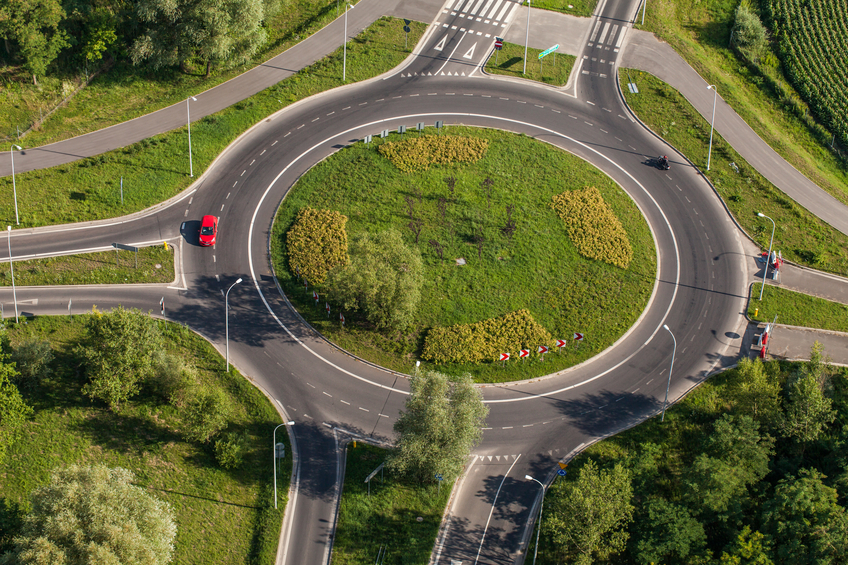Transportation Engineering 15 PDH Discount Package 2
Courses in this Package
Geometric Design for Roads, Streets, Walks and Open Storage Areas (C03-018)
Roundabout Geometric Design (C04-004)
Roundabout Planning and Operation (C05-011)
Roundabout Traffic Design and Landscaping (C03-010)

This online engineering PDH course refers to military design requirements and objectives and provides guidance on the general provisions and geometric design criteria for the design of roads, streets, bridges, walks, parking, residence drives and storage areas. It discusses how geometric design deals with the dimensions of the visible features of a facility such as alignment, sight distances, widths, slopes, and grades.
This 3 PDH online course is applicable to civil and traffic engineers, technical professionals and construction personnel who are interested in gaining a better understanding of geometric design for roadways, walkways and open storage areas.
This PE continuing education course is intended to provide you with the following specific knowledge and skills:
- Understanding the purpose, scope and definitions of geometric design
- Understanding the general provisions for access highway and installation highway design
- Understanding the design basis for roads, streets and storage areas
- Understanding the principles of geometric design for underpass roadways, bridges, walks, parking and residence drives
In this professional engineering CEU course, you need to review the course document titled "General Provisions and Geometric Design for Roads, Streets, Walks and Open Storage Areas" prepared by the Department of Defense, Unified Facilities Criteria Publication "UFC 3-250-18FA", January 2006.
Upon successful completion of the quiz, print your Certificate of Completion instantly. (Note: if you are paying by check or money order, you will be able to print it after we receive your payment.) For your convenience, we will also email it to you. Please note that you can log in to your account at any time to access and print your Certificate of Completion.

This online engineering PDH course presents the fundamental design principles common among all roundabout types. This course also presents detailed design considerations specific to multilane roundabouts, rural roundabouts, and mini-roundabouts.
Designing the geometry of a roundabout involves choosing between trade-offs of safety and capacity. Roundabouts operate most safely when their geometry forces traffic to enter and circulate at slow speeds. Horizontal curvature and narrow pavement widths are used to produce this reduced-speed environment. Conversely, the capacity of roundabouts is negatively affected by these low-speed design elements. As the widths and radii of entry and circulatory roadways are reduced, the capacity of the roundabout is also reduced.
Furthermore, many of the geometric parameters are governed by the maneuvering requirements of the largest vehicles expected to travel through the intersection. Thus, designing a roundabout is a process of determining the optimal balance between safety provisions, operational performance, and large vehicle accommodation.
This 4 PDH online course is applicable to traffic engineers, transportation planners, managers, and other technical professionals who are involved in the geometric design of roundabouts.
This PE continuing education course is intended to provide you with the following specific knowledge and skills:
- Familiarizing with the different types of roundabouts
- Understanding the geometric elements
- Learning the general design principles
- Selecting the appropriate inscribed circle diameter
- Designing the alignment of approaches
- Designing entry and exit curves
- Designing the central and splitter islands
- Determining the stopping and intersection sight distances
- Designing methods to avoid vehicle path overlap
In this professional engineering CEU course, you need to review Chapter 6, "Geometric Design", of the Federal Highway Administration Publication FHWA-RD-00-067, "Understanding Roundabouts".
Upon successful completion of the quiz, print your Certificate of Completion instantly. (Note: if you are paying by check or money order, you will be able to print it after we receive your payment.) For your convenience, we will also email it to you. Please note that you can log in to your account at any time to access and print your Certificate of Completion.

This online engineering PDH course presents the factors that lead up to the decision to construct a roundabout with an approximate configuration at a specific location, preceding the detailed analysis and design of a roundabout. By confirming that there is good reason to believe that roundabout construction is feasible and that a roundabout offers a sensible method of accommodating the traffic demand, these planning activities make unnecessary the expenditure of effort required subsequently.
This course also presents methods for analyzing the operation of an existing or planned roundabout. These methods allow a transportation analyst to assess the operational performance of a facility, given information about the usage of the facility and its geometric design elements. An operational analysis produces two kinds of estimates: (1) the capacity of a facility, i.e., the ability of the facility to accommodate various streams of users, and (2) the level of performance, often measured in terms of one or more measures of effectiveness, such as delay and queues.
This 5 PDH online course is applicable to traffic engineers, transportation planners, conceptual and detailed designers, and other technical professionals who are involved in the planning and operation of roundabouts.
This PE continuing education course is intended to provide you with the following specific knowledge and skills:
- Considering the various constraints for constructing a roundabout
- Determining a preliminary lane configuration and selecting a roundabout category based on capacity requirements
- Performing the analysis appropriate to the roundabout selection category
- Determining the space requirements and feasibility
- Understanding the traffic operations at roundabouts
- Obtaining data required to evaluate the performance of a roundabout
- Estimating the capacity of the various roundabout configurations
- Applying measures of effectiveness determine the performance of a roundabout and estimating these measures
- Familiarizing with the different computer software packages available to implement the capacity and performance analysis procedures
In this professional engineering CEU course, you need to review Chapter 4, "Planning" and Chapter 5, "Operation", of the Federal Highway Administration Publication FHWA-RD-00-067, "Understanding Roundabouts".
Upon successful completion of the quiz, print your Certificate of Completion instantly. (Note: if you are paying by check or money order, you will be able to print it after we receive your payment.) For your convenience, we will also email it to you. Please note that you can log in to your account at any time to access and print your Certificate of Completion.

This online engineering PDH course presents guidelines on the design of traffic elements, illumination, and landscaping associated with roundabouts.
The design of these elements is critical in achieving the desired operational and safety features of a roundabout, as well as the desired visibility and aesthetics.
This 3 PDH online course is applicable to traffic engineers, transportation planners, conceptual and detailed designers, and other technical professionals who are involved in the traffic design and landscaping of roundabouts.
This PE continuing education course is intended to provide you with the following specific knowledge and skills:
- Designing the traffic elements including signing, pavement markings and work zone traffic control
- Designing the required illumination
- Landscaping the central island, splitter island and approach
In this professional engineering CEU course, you need to review Chapter 7, "Traffic Design and Landscaping", of the Federal Highway Administration Publication FHWA-RD-00-067, "Understanding Roundabouts".
Upon successful completion of the quiz, print your Certificate of Completion instantly. (Note: if you are paying by check or money order, you will be able to print it after we receive your payment.) For your convenience, we will also email it to you. Please note that you can log in to your account at any time to access and print your Certificate of Completion.